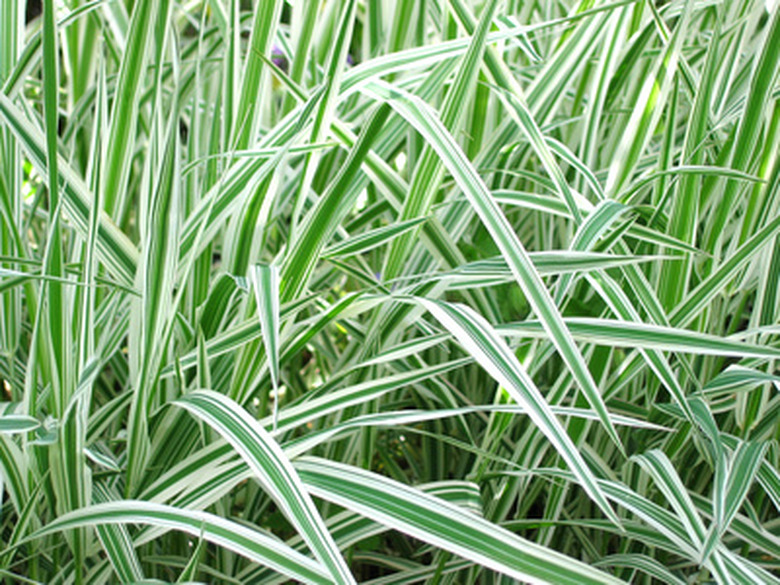Fancy Types Of Grass
Ornamental grasses are those grown for their attractiveness rather than for their usefulness. These fancy types of grass have much to offer, acting as border plants, background plants to flowers and as simple centerpieces. There are a number of hardy ornamental grasses that can be cultivated with ease to add more texture to a garden.
Mexican Feather Grass
Boasting delicate, needle-thin blades in green and silvery gray colors, Mexican feather grass (Nassella tenuissima) is a wonderful clumping ornamental grass that can bring movement into the garden. The blades move at even the softest breeze, rippling the multicolored blades. Native to Mexico, New Mexico and Texas, Mexican feather grass is a highly drought-tolerant plant that grows well in full sunlight or partial shade. Soil should be loose and well drained.
- Ornamental grasses are those grown for their attractiveness rather than for their usefulness.
- Boasting delicate, needle-thin blades in green and silvery gray colors, Mexican feather grass (Nassella tenuissima) is a wonderful clumping ornamental grass that can bring movement into the garden.
Zebra Grass
Zebra grass (Miscanthus sinensis 'Zebrinus') is a clumping grass that can grow to be 7 feet tall, boasting sharply pointed leaves that are horizontally striped with dark green and creamy yellow. The striking plant blooms in the summer until the fall with pale pink flower plumes, creating a distinct overall look. Zebra grass grows well in either full sun or partial sun. The grass isn't picky about soil and is quite drought-tolerant once established.
Chinese Fountain Grass
Cold hardy and elegant, Chinese fountain grass (Pennisetum alopecuroides) is a clumping perennial grass native to Eastern Asia and Australia. The plant boasts thin, cascading blades and fluffy yellowish plumes. The vigorous grower does best in full sunlight, though it will tolerate some shade, and the plant isn't picky about soil. This ornamental grass can be invasive in some areas, so check an invasive species list before planting.
- Zebra grass (Miscanthus sinensis 'Zebrinus') is a clumping grass that can grow to be 7 feet tall, boasting sharply pointed leaves that are horizontally striped with dark green and creamy yellow.
- The vigorous grower does best in full sunlight, though it will tolerate some shade, and the plant isn't picky about soil.
List Of Types Of Grass
Few outdoor surfaces are as inviting as turfgrass. In order to enjoy turfgrass in your yard, it's necessary to familiarize yourself with the various types of grass. Knowing if a certain turfgrass requires warm or cool weather and if it tolerates drought will enable you to choose the ideal lawn grass. How much foot traffic grass can take is another important consideration. Such transitional areas tend to be those states located down the middle of the country. This lawn grass has peak growth during cool weather. Some of the most common cool-season grasses include the following in this grass names list. This means it can stand up to foot traffic and is drought resistant. This grass is one of the easiest cool-season grasses to grow from seed. Fine fescue is widely used throughout northern and central U.S. states, including transition zones. This grass slows down growth in the hot summer months. Perennial ryegrass is widely used throughout the United States for permanent and temporary lawns. As their name suggests, warm-season grasses grow best in warm weather. Winter dormancy for warm-season grasses lasts three to five months. Bermudagrass also stands up to high heat and is tolerant of heavy foot traffic. It isn't as cold tolerant as the other warm-season grasses. This makes it a good choice if you want to quickly seed a lawn. It can be invasive, but its invasiveness enables the grass to endure heavy use. Zoysia is a versatile lawn grass that tolerates high heat, drought and foot traffic. This grass features a broad, medium-green blade and tends to form a thick lawn. Though St. Augustine lawn grass prefers full sun, it has a high tolerance for shade. This grass grows by stolons that creep along the ground. It still grows wild on the western prairies of the United States. Buffalo grass tolerates high heat and drought well. Most buffalo grass varieties won't tolerate a lot of rain, however. Some kinds of grass, such as Bermuda grass, require regular feeding, while other kinds of grass can get by on less fertilizer. Mowing is another issue to consider.
- Few outdoor surfaces are as inviting as turfgrass.
- This lawn grass has peak growth during cool weather.
- Though St. Augustine lawn grass prefers full sun, it has a high tolerance for shade.
References
- Brighterblooms.com: Zebra Grass
- Floridata.com: Mexican Feather Grass
- Floridata.com: Chinese Fountain Grass
- Fine Fescue
- Fine Fescue for Home Lawns
- What are Cool Season Grasses?
- All You Need to Know About Tall Fescue
- Kentucky bluegrass — Poa pratensis
- Ultimate Guide to Cool Season Grasses
- All You Need to Know About Perennial Ryegrass
- All You Need to Know About Bermudagrass
- All You Need to Know About Zoysia Grass
- St. Augustinegrass — Stenotaphrum secundatum
- Buffalo Grass – North America's Native Grass
- Southern, Warm Season Grasses
